Main content starts here.
Foreign Languages > Chiba International Information Square - To foreign residents - > Chiba Nanohana News > Chiba Nanohana News (Past Issues) > Chiba Nanohana News (December 2021)
Update: December 21, 2021
Chiba Nanohana News (December 2021)
Index
I. Festivals and Events
1)Spots to See the First Sunrise of the New Year
One highlight of New Year’s festivities in Japan is seeing the first sunrise of the New Year, hatsuhinode. Chiba Prefecture has some of the best places in the country to see the sunrise. Get a great start to 2022 at one of these spots!
Cape Inubo (Choshi City)
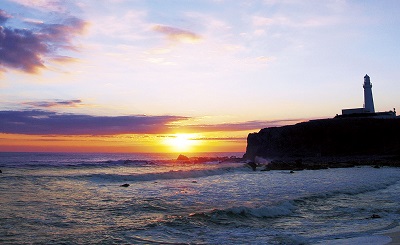
Cape Inubo boasts the earliest sunrise (6:46 a.m.) in all of Japan, excluding mountain summits and outlying islands.
- Location: Cape Inubo, Choshi City
- Access: 10 min walk from the Choshi Electric Railway Inubo Station
- Inquiries: Choshi City Tourism Association TEL 0479-22-1544
Umihotaru PA (Kisarazu City)
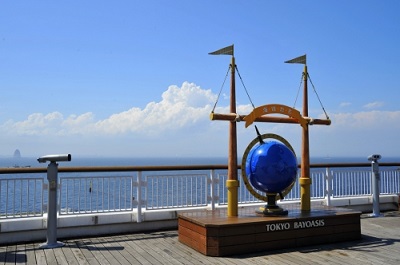
Why not enjoy the first sunrise of the year from Umihotaru PA, located at the center of the Tokyo Bay Aqualine, which connects Kisarazu and Kawasaki? Seeing the sunrise from the middle of Tokyo Bay is a special treat.
- Location: Nakajima, Kisarazu City
- Access: Tokyo Bay Aqualine
- Inquiries: Trans-Tokyo Bay Highway Corporation TEL 0438-41-7401
Kujukutani Valley Observation Park (Kimitsu City)
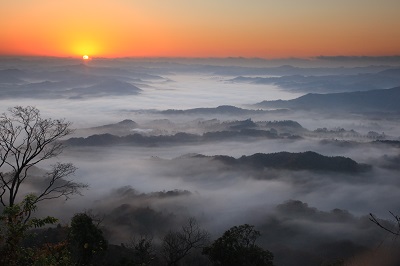
You are able to see the entire Boso Hill Range from the Kujukutani Valley Observation Park. The view is especially gorgeous from dawn to right after the sun begins to appear, creating a painting-like view with a sea of clouds appearing right beneath your eyes.
- Location: Kujukutani Valley Observation Park/119-1 Kanozan, Kimitsu City
- Access: from Kimitsu Interchange, take the Prefectural Road 92 in the Kamogawa direction through Higashiawakura for about 25 minutes
- Inquiries: Kimitsu City Economic Promotion Division TEL 0439-56-1325
Seichoji Temple Asahigamori (Kamogawa City)
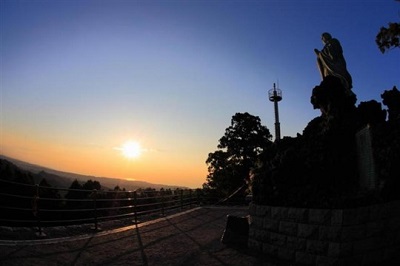
The sunrise from Asahigamori was selected as one of the top 100 places to see the sunrise in Japan, making it perfect for the first sunrise of the year. You can also make your first shrine visit of the year at Seichoji Temple.
- Location: 322-1 Kiyosumi, Kamogawa City
- Access: 15 minutes on Kamogawa Community Bus in the Kiyosumi direction, departing from the JR Sotobo Line Awa-Amatsu Station
- Inquiries: Seichoji Temple TEL 04-7094-0525
2) Recommended Hatsumode (New Year's Shrine Visit) Spots in Chiba
After seeing the first sunrise of 2022 and eating traditional New Year’s food, you’ll want to wrap up your Japanese oshogatsu experience with hatsumode, the first shrine visit of the New Year. Here are some famous places to enjoy the festivities, as well as some new spots to explore.
Chiba Shrine (Chiba City)
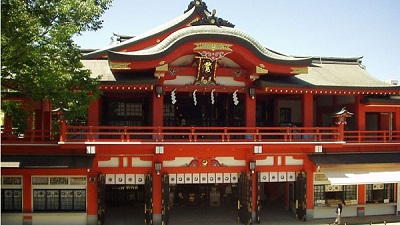
Chiba Shrine honors the North Star and the Big Dipper as “Myoken-sama,” which is thought to offer protection from bad luck and bodily harm. Approximately 650,000 visitors come to Chiba Shrine over the first three days of the New Year.
- Location: 1-16-1 Innai, Chuo-ku, Chiba City
- Access: 10 min walk from Chiba Station (JR Sobu Line or Keisei Line)
- Inquiries: TEL 043-224-2211 (Chiba Shrine)
Hokekyoji Temple (Ichikawa City)
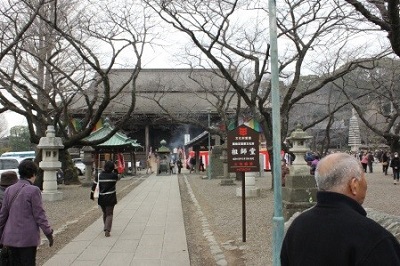
There are important cultural assets within this temple built as a temple of the Nichiren School of Buddhism in the Kamakura Period. Large crowds are expected on New Year’s Eve, as the public will be allowed to ring the bell in the bell tower (1,000 early arrivals estimated).
- Location: 2-10-1 Nakayama, Ichikawa City
- Access: 10 min walk from the JR Sobu Line Shimosa-Nakayama Station or 5 min walk from the Keisei Line Keisei Nakayama Station
- Inquiries: TEL 047-334-3433 (Hokekyoji Temple)
Naritasan Shinshoji Temple (Narita City)
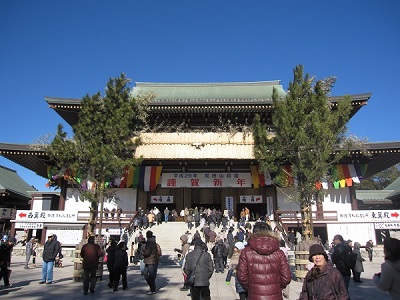
Nationally renowned as Narita’s O-Fudo-sama, approximately 3,000,000 visitors come to worship here during the first 3 days of the New Year (the largest number of visitors in the nation for a temple).
The temple grounds also house the 165,000 square meter Naritasan Park, a beautiful park where you can enjoy the beauty of all 4 seasons.
- Location: 1 Narita, Narita City
- Access: 15 min walk from Narita Station (JR Narita Line) or Keisei Narita Station (Keisei Line)
- Inquiries: TEL 0476-22-2111 (Naritasan Shinshoji Temple)
Katori Jingu Shrine (Katori City)
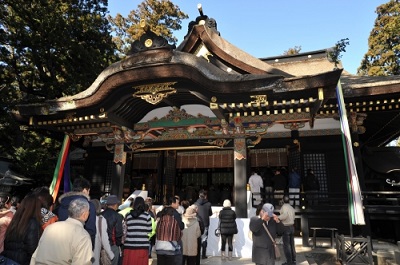
Enshrined at Katori Jingu Shrine is Futsunushi-no-Okami, a deity who appears in many famous Japanese mythologies. Katori Jingu Shrine is famous for being the ichinomiya, or highest-ranking shrine, of the former Shimosa Province, and also for being a jingu, a shrine connected to the Imperial House of Japan. In addition, this shrine possesses a national treasure, the "Kaiju Budo Kyo" (Sea Beast Glazed Mirror), and many other Important Cultural Properties.
- Location: 1697-1 Katori, Katori City
- Access: 30 min walk or 10 min by taxi from Sawara Station (JR Narita Line)
- Inquiries: TEL 0478-57-3211 (Katori Jingu Shrine)
Nihonji Temple (Kyonan Town)
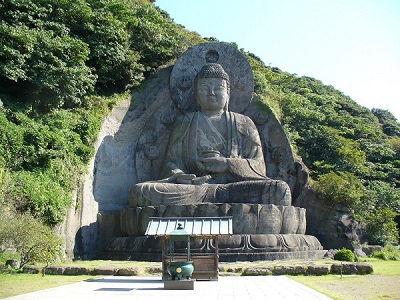
Opened in the year 725 by the then-reigning Emperor, this temple is located within Nokogiriyama boasting a 31 meter tall Daibutsu Buddha statue, along with several smaller Buddhas carved into the rocks nearby.
- Location: Motona, Kyonan Town, Awa Gun
- Access: 8 min walk to the entrance of the Nokogiriyama Ropeway from the JR Uchibo Line Hamakanaya Station, ride the ropeway to the top, and walk 10 min to Nihonji Temple.
- Inquiries: TEL: 0470-55-1103 (Nihonji Temple)
Tokyo Bay Kannon (Futtsu City)
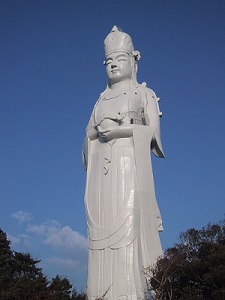
The Thirteen Buddhas and Seven Gods of Fortune, said to bring happiness and prosperity, are located throughout the 20 floors of the Tokyo Bay Kannon. You can pray to each of these holy figures as you climb the statue and enjoy spectacular views.
-
Location: 1588 Kokubo, Futtsu City
-
Access: 6 min by taxi from Sanukimachi Station (JR Uchibo Line)
-
Inquiries: TEL 0439-65-1222 (Tokyo Bay Kannon)
Tamasaki Shrine (Ichinomiya Town)
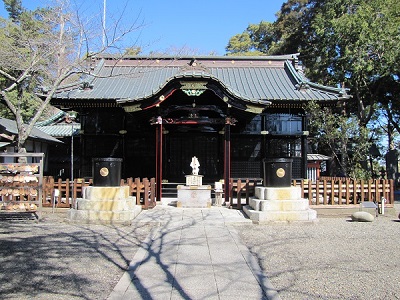
At Tamasaki Shrine, you can see the earliest sunrise from a shrine in the entire Kanto area.
There will also be amazake and Kazusa Kagura, ancient Shinto music and dancing designated as a Prefectural Intangible Folk Culture Asset.
-
Location: 3048 Ichinomiya, Ichinomiya Town, Chosei Gun
-
Access: 7 min walk from Kazusa-Ichinomiya Station (JR Sotobo Line)
-
Inquiries: TEL 0475-42-2711 (Tamasaki Shrine)
Awa Shrine (Tateyama City)
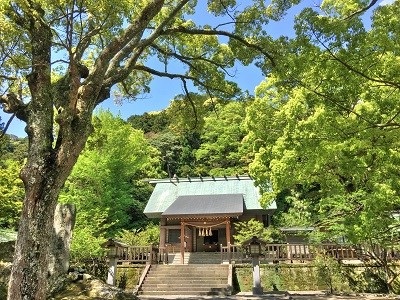
This shrine’s history is said to date back to over 2,670 years ago. Visitors come here to pray for safe travels, good luck, protection from bad luck, safety for one’s family, and success in business.
-
Location: 589 Daijingu, Tateyama City
-
Access: 5 min walk from the Awa Shrine bus stop on the JR bus bound for Awa-Shirahama via Awa-Kanbe departing from the east exit of Tateyama Station (JR Uchibo Line)
-
Inquiries: TEL 0470-28-0034 (Awa Shrine)
3) The Limited-Time Chiba I-CHI-BA Antenna Shop is Open Again This Year until December 18!


This year marks the seventh time Chiba’s antenna shop is open at KITTE Marunouchi in Tokyo for a limited time until December 18!
This year’s theme is “Rediscovering Chiba’s Specialties.” We are looking forward to welcoming you with a variety of popular local products of Chiba that can only be purchased in local areas of the Prefecture.
In addition, producers are promoting and selling their specialty products on a daily basis, and hands-on workshops are held on weekends.
We hope you enjoy Chiba I・CHI・BA, which brings the unknown charms of Chiba Prefecture to Tokyo!
<Contents of Main Products>
About 380 products are for sale, most of which are unique to Chiba Prefecture.
- Agricultural products and processed foods, such as sweets using peanuts, pears, loquats, strawberries, etc.
- Marine products and processed foods such as red bream, sardines, horse mackerel, seaweed, etc.
- Traditional crafts such as Boshu uchiwa (fan), etc.
- Locally brewed sake and beer
- Miscellaneous goods, CHI-BA+KUN goods, etc.
<Giveaway Project>
- Detective CHI-BA+KUN Kuru-kuru Calendar
Visitors to the antenna shop who fill out a survey will receive a limited-edition “Detective CHI-BA+KUN Kuru-kuru Calendar (2022).” (Given to the first 100 people per day.) - Original stamp & postcard set
Visitors who spend 3,000 yen or more (including tax) will receive a gift of an “Original Stamp & Postcard Set” only available at the antenna shop! (Given to the first 20 people per day.)
※COVID-19 infection prevention measures such as temperature checks, hand disinfection, and the wearing of a mask are thoroughly enforced upon entry. In addition, the shops will be laid out to avoid the Three C’s.
-
Location: Tokyo City i Performance Zone, KITTE Basement 1F,
2-1-2 Marunouchi, Chiyoda-ku, Tokyo (1 min walk from Tokyo Station Marunouchi South Exit) -
Duration: Open every day from Nov. 20, 2021 (Sat) until Dec. 18, 2021 (Sat)
-
Time: 10:00 am ~ 8:00 pm (until 5:00 pm on the last day of the event)
-
Social media account:@chibaichiba2021 (Twitter & Instagram)
- Inquiries: Chiba Prefecture Tourism Planning Division TEL: 043-223-2415
4) Daffodil Festival/Ezuki Daffodil Road & Okuzure Suisenkyo (Kyonan Town)
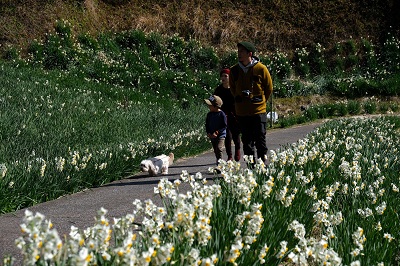
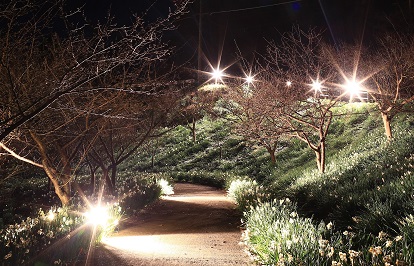
Since long ago, the Minamiboso (southern Chiba) region has been so warm that it has been said, “once you cross over Mt. Nokogiri, you need one less layer of clothing.” Even when the northern regions of Japan are covered in snow, the Minamiboso region is painted with flowers.
Flowers growing in the Boshu region (now referred to as the Minamiboso region), were said to originate in the Ansei Period (1854-1860). During this time, the Japanese daffodils that grew in the Hota district were called “Motona daffodils,” and transported to Edo (Tokyo) by boat.
<Ezuki Daffodil Road>
Once the shipment time has passed, the daffodils are preserved for viewing. These daffodils are in full bloom on both sides of this 3km stretch of the local town road, which is referred to as the Ezuki Daffodil Road. During the Daffodil Festival, you can purchase locally produced fruits and vegetables from local farmers and daffodil flowers as you enjoy an earlier spring.
Thanks to the local climactic conditions, Kyonan’s daffodils are characterized by their strong fragrance and tall stalks. The peak for daffodil viewing is from mid-December to the end of January.
<Okuzure Suisenkyo>
The contrast of the Japanese daffodils with the green leaves and golden fruit of the surrounding mikan trees stand out against the winter sky. Also, early blossoms of red and white plum flowers towards the end of January will welcome you.
During the Daffodil Festival, the Daffodil Road at Sakuma Dam Park will be illuminated in conjunction with the blooming of daffodils.
As the viewing season for the daffodils draws to an end, the season for the early blooming cherry blossom trees of Sakuma Dam Park will begin. The “Yoritomo-zakura,” one of Kyonan Town’s symbols, will begin blossoming in mid-February. You can also enjoy the Tairyo-zakura, Kanhi-zakura, Higan-zakura, Somei-Yoshino, Shidare-zakura, and Yae-zakura cherry trees until mid-April.
-
Time Period: Saturday, December 11 - Sunday, February 6
- Location:
1.Ezuki Daffodil Road /Ezuki area, Kyonan Town
2.Okuzure Suisenkyo /Okuzure area, Kyonan Town -
Access:
1.For Ezuki Daffodil Road/ 15 minutes on foot from Hota Station on the JR Uchibo Line to the entrance of the Daffodil Road
2.For Okuzure Suisenkyo/ Take the Town Circulating Bus from Hota Station or Awa-Katsuyama Station on the JR Uchibo Line - Inquiries: Kyonan Town Tourism Association TEL: 0470-55-1683
|
|
|
